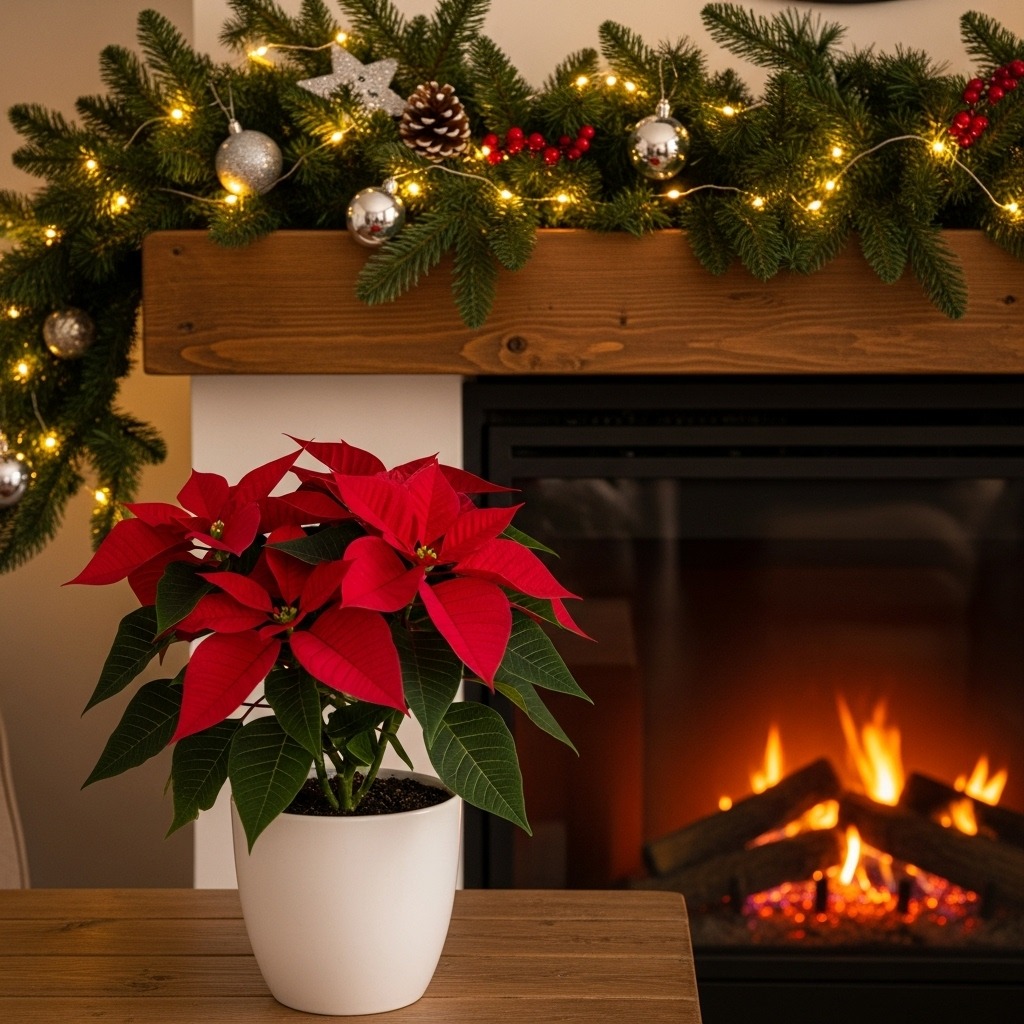The Christmas cactus (Schlumbergera bridgesii) is one of the most beloved holiday houseplants, known for its vibrant blooms that burst forth just in time for the festive season.
Unlike desert cacti, this tropical beauty thrives in humidity and indirect light, making it an ideal choice for indoor gardeners.
If you’ve ever struggled to get your Christmas cactus to bloom or wondered how to keep it healthy year-round, these detailed care tips and bloom tricks will help you enjoy a stunning display every Christmas.
1. Understanding the Christmas Cactus
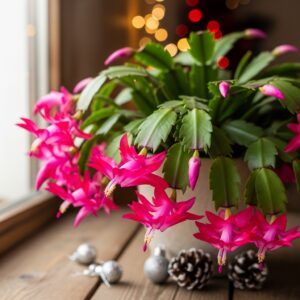
The Christmas cactus is native to the coastal mountains of Brazil, where it grows in shaded, humid forests rather than arid deserts.
This means it prefers conditions quite different from what we usually associate with cacti — moist soil, moderate temperatures, and filtered light.
It blooms around December, producing bright pink, red, or white flowers that last several weeks.
Recognizing its tropical origins helps you mimic the right growing environment indoors.
2. Light Requirements — Bright but Indirect

One of the key secrets to keeping your Christmas cactus happy is providing the right light.
Place it near a bright window, but avoid direct sunlight, which can scorch its leaf segments.
North or east-facing windows are ideal.
If your plant lives in a darker spot, consider rotating it weekly or supplementing with a grow light during the shorter winter days to encourage healthy growth and blooming.
3. Ideal Temperature and Humidity Levels

Christmas cacti prefer cooler temperatures and moderate humidity, especially during their blooming phase.
Daytime temperatures between 65–70°F (18–21°C) and slightly cooler nights around 60°F (15°C) are perfect.
To increase humidity, you can place a tray of water near the plant or use a humidifier during dry winter months.
Avoid placing your cactus near heating vents or drafty windows, as sudden temperature changes can cause bud drop.
4. Proper Watering Technique
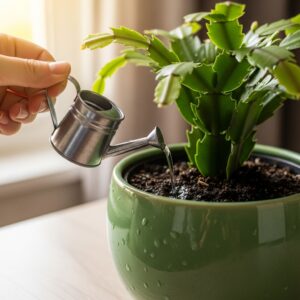
Unlike desert cacti, the Christmas cactus enjoys evenly moist soil — but not soggy roots.
Water your plant thoroughly when the top inch of soil feels dry to the touch.
Always allow excess water to drain completely to prevent root rot.
During its active growing season (spring and summer), water more frequently, and slightly reduce watering in fall as the plant prepares for its blooming cycle.
5. Choosing the Right Soil and Pot

Well-draining soil is essential to prevent root issues.
A potting mix designed for succulents or orchids works perfectly.
You can also create your own mix by combining two parts peat moss, one part perlite, and one part potting soil.
Make sure the pot has drainage holes to allow excess moisture to escape.
Terracotta or ceramic pots are great choices as they promote good air circulation around the roots.
6. Fertilizing for Healthy Growth

Feed your Christmas cactus every two to four weeks during the spring and summer using a balanced, water-soluble fertilizer diluted to half strength.
This will encourage lush green growth.
Stop fertilizing around early fall (September) to allow the plant to rest before its blooming season.
Over-fertilizing close to bloom time can actually reduce flower production, so timing is key.
7. Encouraging Bloom — The Light & Temperature Trick

Getting your Christmas cactus to bloom on time can be a little tricky, but with the right care, it’s completely manageable.
Starting around mid-October, give your cactus about 12–14 hours of complete darkness each night for 6–8 weeks.
You can place it in a dark closet or cover it with a box during nighttime. At the same time, keep it in cooler temperatures (around 55–60°F / 13–15°C).
This combination of darkness and cool air triggers the bud formation that leads to holiday blooms.
8. Handling Bud Drop Issues
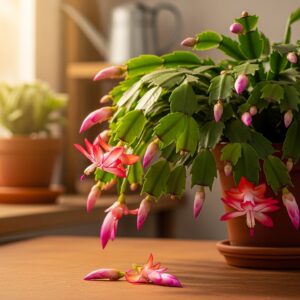
If your Christmas cactus forms buds but drops them before opening, don’t worry — this is a common issue.
The main culprits are sudden changes in light, temperature, or watering routines.
Try to keep the environment consistent once buds appear.
Avoid moving the plant too often, and maintain steady moisture without overwatering.
Once the flowers bloom, keep the plant in indirect light to prolong the display.
Also Check: 7 Sunflower Table Centerpieces
9. Post-Bloom Care & Rest Period

After your cactus finishes blooming, it will need a short rest period to regain energy.
Reduce watering slightly and keep it in a cool, bright spot.
After a month or so, you can resume regular watering and light fertilizing.
This rest period helps the plant prepare for new growth in spring, ensuring a stronger bloom the following year.
10. Pruning & Propagation

Once the flowering season is over, pruning helps maintain the plant’s shape and promotes branching.
Simply twist or snip off a few segments from the ends of the stems.
You can use these cuttings to propagate new plants — let them dry for a day, then plant them in a moist, sandy mix.
In a few weeks, they’ll develop roots and begin growing, making perfect gifts for friends and family next Christmas.
11. Common Pests & Problems
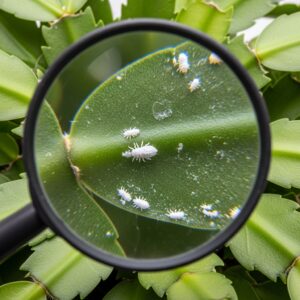
Christmas cacti are generally low-maintenance but can sometimes attract pests like mealybugs, fungus gnats, or spider mites.
Regularly inspect the leaves and rinse them with water to remove dust and bugs.
If needed, apply a gentle insecticidal soap.
Yellowing leaves often indicate overwatering or poor drainage, while shriveled segments may suggest underwatering or too much direct sunlight.
12. Repotting Every Few Years
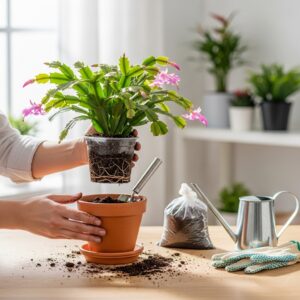
Although Christmas cacti like to be slightly root-bound, repotting every 2–3 years keeps the soil fresh and nutrient-rich.
The best time to repot is after the blooming season, usually in late winter or early spring.
Choose a pot only slightly larger than the previous one, and refresh the soil mix for optimal growth.
A thriving Christmas cactus is a true symbol of holiday warmth and care.
With the right light, temperature, and watering routine — along with a bit of patience — your plant will reward you with spectacular blooms that brighten your home each festive season.
Follow these bloom-time tricks, and you’ll soon have a Christmas cactus that not only survives but thrives for years to come.
FAQs
1. How long does a Christmas cactus live?
With proper care, a Christmas cactus can live for 20–30 years — some even longer, passed down through generations.
2. Can I make my Christmas cactus bloom more than once a year?
Yes! With controlled light and temperature cycles, you can sometimes encourage a second bloom in spring.
3. Why is my Christmas cactus not blooming?
It likely didn’t get enough darkness or cool temperatures during the pre-bloom period. Follow the 6–8 week darkness trick to help it set buds.
4. Should I mist my Christmas cactus?
Yes, occasional misting can help increase humidity, especially in dry indoor air during winter.
5. Can I keep my Christmas cactus outside?
Yes, but only in warm, shaded spots during summer. Bring it indoors before temperatures drop below 50°F (10°C).
